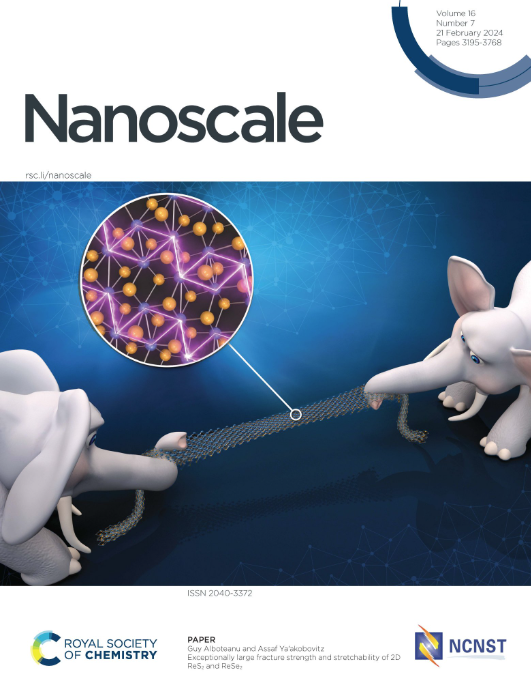用于可激活光动力疗法的 pH 响应型自组装聚合物-光敏剂共轭物
IF 5.8
3区 材料科学
Q1 CHEMISTRY, MULTIDISCIPLINARY
引用次数: 0
摘要
本文报告了一种两亲性聚氨酯(P1S)的合成、水性自组装及其在 pH 触发的可激活光动力疗法中的相关性,该聚氨酯使用了一种不含重原子的有机光敏剂。在一定量的 (S)-2-甲基丁-1-醇(阻链剂)和 DABCO 催化剂的作用下,1,4-二异氰酸丁烷与两种不同的二羟基单体(一种具有亲水性楔形悬垂基,另一种具有活性羰基的 1,3- 二羟基丙-2-酮)发生缩合聚合反应,生成活性预聚物 P1。作为光敏剂的酰肼官能化硫代-萘醌亚胺(NMIS)与 P1 的羰基官能化反应,得到了所需的聚合物-光敏剂共轭物 P1S,其中染料通过酸性肼连接体附着在聚合物骨架上。从 UV/Vis、CD 和小角 X 射线衍射研究中可以看出,在水中,P1S 采用链内 H 键稳定的折叠结构,并进一步组装成聚合物体结构(Dh ~ 200 nm),其中疏水膜由聚集的 NMIS 和三烷氧基苯发色团组成。在聚集状态下,NMIS 失去了生成活性氧(ROS)的能力,处于休眠状态。然而,在酸性条件下(pH 值为 5.5),光敏剂脱离(可能是由于腙连接体的裂解),并在光照射下恢复其生成 ROS 的全部活性,这一点可以从标准的 DCFH 检测中得到证明。为了测试这种 pH 值可激活的细胞内 ROS 生成的可能性,我们用 HeLa 细胞处理了 P1S,因为众所周知,癌细胞比正常细胞更具酸性。事实上,DCFH 试验证明了光辐射诱导细胞内 ROS 的产生,从而有效地杀死了细胞。本文章由计算机程序翻译,如有差异,请以英文原文为准。
pH-Responsive Self-assembled Polymer-Photosensitizer Conjugate for Activable Photodynamic Therapy
This paper reports synthesis, aqueous self-assembly and relevance in the pH-triggered activable photodynamic therapy of an amphiphilic polyurethane (P1S), functionalized with a heavy-atom free organic photosensitizer. Condensation polymerization between 1,4-diisocyanatobutane and two different dihydroxy monomers (one having pendant hydrophilic wedge and the other having 1,3-dihydroxypropan-2-one with a reactive carbonyl-group) in presence of measured amount of (S)-2-methylbutan-1-ol (chain-stopper) and DABCO catalyst produces the reactive pre-polymer P1. Hydrazide- functionalized thionated-naphthalenemonimide (NMIS), that acts as a photosensitizer, was reacted with the carbonyl-functionality of P1 to get the desired polymer-photosensitizer conjugate P1S in which the dye was attached to the polymer backbone by the acid-labile hydrazone linker. In water, P1S adopted intra-chain H-bonding stabilized folded structure, which further assembled to produce polymersome structure (Dh ~ 200 nm), in which the hydrophobic membrane consists of aggregated NMIS and trialkoxy-benzene chromophores, as evident from the UV/Vis, CD and small-angle X-ray diffraction studies. In the aggregated state, the NMIS loses its reactive oxygen species (ROS)-generation ability and remains in the dormant state. However, in acidic condition (pH 5.5), the photosensitizer is detached (presumably due to the cleavage of the hydrazone-linker) and regains its full ROS-generation activity under photoirradiation, as evidenced from the standard DCFH assay. To test the possibility of such pH-activable intra-cellular ROS generation, P1S was treated with HeLa cells as it is known that cancer cells are more acidic than normal cells. Indeed, photoirradiation induced intra-cellular ROS generation was evident by the DCFH assay, resulting in efficient cell killing.
求助全文
通过发布文献求助,成功后即可免费获取论文全文。
去求助
来源期刊

Nanoscale
CHEMISTRY, MULTIDISCIPLINARY-NANOSCIENCE & NANOTECHNOLOGY
CiteScore
12.10
自引率
3.00%
发文量
1628
审稿时长
1.6 months
期刊介绍:
Nanoscale is a high-impact international journal, publishing high-quality research across nanoscience and nanotechnology. Nanoscale publishes a full mix of research articles on experimental and theoretical work, including reviews, communications, and full papers.Highly interdisciplinary, this journal appeals to scientists, researchers and professionals interested in nanoscience and nanotechnology, quantum materials and quantum technology, including the areas of physics, chemistry, biology, medicine, materials, energy/environment, information technology, detection science, healthcare and drug discovery, and electronics.
 求助内容:
求助内容: 应助结果提醒方式:
应助结果提醒方式:


